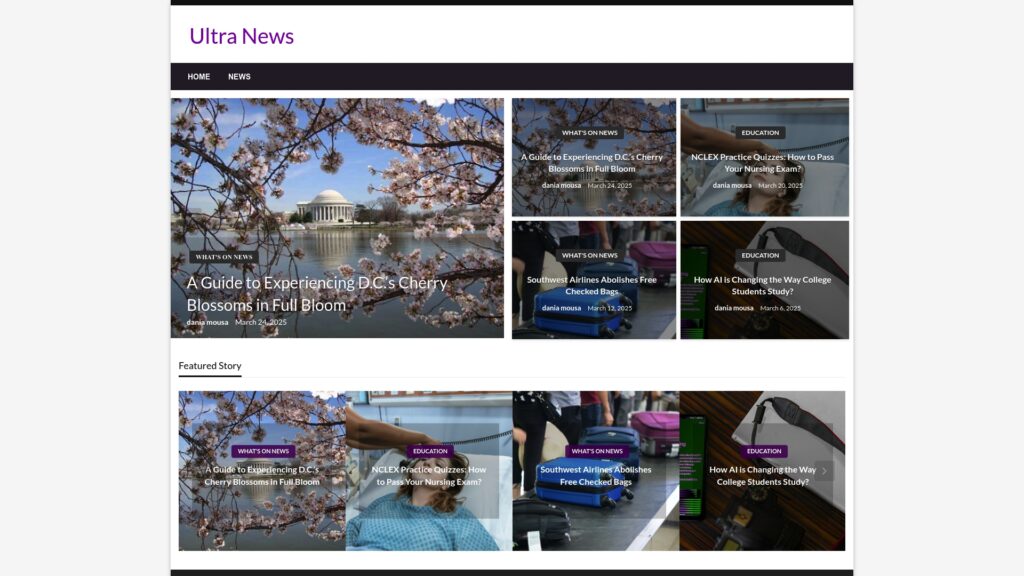
News media reaches billions of people every day and shapes the way we see our world. Suddenly, the options seem endless and the rules have changed. Over 70 percent of Americans now get at least some of their news online, but that is just one piece of a much bigger puzzle. Traditional outlets, digital platforms, blogs, and podcasts all fight for attention and trust—so why are the old-school sources still so influential while brand new formats keep popping up everywhere?
Table of Contents
- Traditional News Media: Newspapers, TV, and Radio
- Digital News Media: Online Platforms And Social Media
- Specialized And Emerging News Sources: Blogs And Podcasts
- Comparing Credibility And Impact Of News Media Types
Quick Summary
| Takeaway | Explanation |
|---|---|
| Traditional media still holds significance | Newspapers, TV, and radio provide in-depth, investigative reporting essential for community understanding. |
| Digital news consumption is rapidly growing | Online platforms and social media are reshaping how news is accessed, emphasizing speed and user engagement. |
| Podcasts enhance specialized content delivery | Podcasts offer unique, in-depth storytelling, catering to niche audiences with personal and engaged content. |
| Credibility is increasingly complex | Different media types face unique credibility challenges, requiring consumers to evaluate sources carefully. |
| Emerging formats blend traditional and digital | Hybrid models, like blogs and podcasts, combine rigorous journalism with the immediacy of digital platforms. |
Traditional News Media: Newspapers, TV, and Radio
Traditional news media represents the foundational platforms that have informed and connected communities for generations. Despite the digital revolution, newspapers, television, and radio continue to play crucial roles in news dissemination and public communication.
The Enduring Power of Print Newspapers
Newspapers remain a significant source of in-depth reporting and comprehensive news coverage. Pew Research Center reveals that while print circulation has dramatically declined, digital newspaper readership has emerged as a critical alternative. Traditional newspapers have adapted by developing robust online platforms, ensuring their continued relevance in the rapidly changing media landscape.
The core strength of newspapers lies in their ability to provide detailed investigative reporting and long-form journalism. Professional journalists spend weeks or months researching complex stories, offering readers nuanced perspectives that short-form digital content often cannot match. Local newspapers particularly remain essential for community-level reporting, covering municipal events, local government actions, and neighborhood stories that larger media outlets might overlook.
Television News: Visual Storytelling and Real-Time Reporting
The FCC’s research highlights television’s unique position in news media. Television news combines visual storytelling with immediate reporting, creating powerful narrative experiences that engage viewers emotionally and intellectually. Local TV news stations continue to be trusted sources of regional information, providing weather updates, community events, and breaking news with unprecedented immediacy.
Broadcast networks invest significant resources in news production, maintaining extensive reporting teams across national and international locations. These networks offer comprehensive coverage of major events, political developments, and social issues, presenting complex narratives through expert commentary and on-the-ground reporting.
Radio: The Intimate News Medium
Radio represents an often underappreciated yet powerful news medium. Its accessibility and portability make it unique among traditional media platforms. Public radio stations, in particular, provide in-depth analysis, investigative reporting, and diverse perspectives that complement visual media. Morning and evening news programs continue to be primary information sources for millions of listeners during commutes and daily routines.
Unlike visual media, radio allows listeners to consume news while simultaneously engaging in other activities. This multitasking capability ensures its continued relevance in an increasingly busy world. Talk radio shows also offer platforms for public discourse, featuring interviews, panel discussions, and direct audience interactions that create dynamic communication environments.
While digital platforms have transformed media consumption, traditional news media remain essential. Each platform newspapers, television, and radio offers distinct strengths that continue to inform, educate, and connect communities in meaningful ways.
Below is a table summarizing the unique strengths and features of each traditional news media type discussed above.
| Media Type | Key Features | Strengths |
|---|---|---|
| Newspapers | In-depth investigative reporting, Local focus | Nuanced analysis, Community coverage |
| Television | Visual storytelling, Real-time reporting | Emotional engagement, Broad audience reach |
| Radio | Accessibility, Portability, Multitasking | Intimate, Continuous updates, Public discourse |
Digital News Media: Online Platforms and Social Media
Digital news media has fundamentally transformed how people consume, share, and interact with information. Online platforms and social media have emerged as powerful channels that reshape news distribution, offering unprecedented speed, accessibility, and user engagement.
News Websites and Digital Journalism
Online news platforms represent the digital evolution of traditional journalism. Pew Research Center reports that digital news consumption continues to grow rapidly, with more people accessing news through websites and mobile applications. These platforms provide real-time updates, multimedia content, and interactive features that traditional media cannot match.
Digital journalism offers unique advantages including instant publication, global reach, and the ability to incorporate various media formats like videos, infographics, and interactive maps. Professional news organizations have invested heavily in developing robust online infrastructures that enable comprehensive and dynamic news reporting. Specialized digital newsrooms now focus on creating content specifically designed for online consumption, understanding the different reading habits and preferences of digital audiences.
Social Media as News Distribution Channels
Reuters Digital News Report highlights the significant role social media platforms play in news dissemination. Networks like Twitter, Facebook, and LinkedIn have become critical channels for breaking news, allowing users to share information instantly and participate in global conversations. These platforms enable citizen journalism, where individuals can report events in real-time, often providing perspectives and coverage unavailable through traditional media sources.
However, social media news consumption presents complex challenges. The algorithmic curation of news feeds can create echo chambers, where users are primarily exposed to information that confirms their existing beliefs. This phenomenon raises critical questions about information diversity, media literacy, and the potential for misinformation spread. Platforms are increasingly implementing fact-checking mechanisms and transparency features to address these concerns.
Emerging Digital News Formats
The digital news landscape continually evolves with innovative formats and consumption methods. Podcasts, video news streams, and interactive storytelling represent emerging trends that cater to diverse audience preferences. Short-form video content on platforms like TikTok and YouTube has created new avenues for news presentation, particularly among younger demographics who prefer quick, engaging information delivery.
News aggregation services and personalized news apps further demonstrate the sophistication of digital news media. These platforms use artificial intelligence and machine learning to curate content based on individual user interests, creating highly customized news experiences. Users can now receive tailored news updates that align with their specific preferences, geographic locations, and reading habits.
Digital news media represents more than a technological shift it signifies a fundamental transformation in how societies create, consume, and understand information. While presenting remarkable opportunities for global communication, these platforms also demand increased critical thinking and media literacy from consumers navigating an increasingly complex information ecosystem.
Specialized and Emerging News Sources: Blogs and Podcasts
Specialized news sources have revolutionized information consumption, offering audiences targeted content that goes beyond traditional media formats. Blogs and podcasts have emerged as powerful platforms that provide deep, niche insights across numerous topics and industries.
The Rise of Blog Journalism
Knight Foundation research highlights how specialized digital platforms have transformed news consumption. Blogs represent a unique intersection of personal perspective and professional reporting, allowing writers to explore topics with unprecedented depth and authenticity. Independent bloggers and professional journalists alike leverage these platforms to deliver specialized content that traditional media often overlooks.
Blogs offer several distinctive advantages. They provide space for long-form analysis, allowing writers to deconstruct complex issues with nuance and personal insight. Niche blogs focusing on specific domains like technology, science, health, and local politics create communities of engaged readers seeking expert perspectives. These platforms enable direct reader interaction through comments and social sharing, creating dynamic conversations around important topics.
Podcasts: The Audio Journalism Revolution
MIT’s research demonstrates podcasts have become a critical medium for in-depth storytelling and specialized reporting. Unlike traditional radio, podcasts offer on-demand content that listeners can consume at their convenience. These audio platforms cover an extraordinary range of subjects, from investigative journalism and true crime to academic discussions and entertainment commentary.
Podcasts excel at providing intimate, conversational approaches to news and information. Long-form interview formats allow for deeper exploration of complex topics, giving experts and storytellers unprecedented opportunities to share comprehensive insights. Many podcasts have developed loyal listener bases by offering consistent, high-quality content that traditional media cannot match in depth and personal connection.
Emerging Trends in Specialized Media
The landscape of specialized news sources continues to evolve rapidly. Hybrid formats combining blog writing with podcast production are becoming increasingly popular. Creators are developing multi-platform strategies that leverage different media strengths, creating rich, interconnected content experiences. Some podcasts now include companion blogs, while bloggers are producing supplementary audio content.
These specialized platforms democratize information distribution. They provide voices to experts, researchers, and passionate individuals who might not find representation in mainstream media. Podcasts and blogs allow for granular exploration of topics, offering listeners and readers perspectives that are both deeply personal and rigorously researched.

To help understand the differences between blogs and podcasts as specialized news sources, the table below compares their main characteristics and advantages as discussed.
| Platform | Content Style | Main Advantages | Interaction Type |
|---|---|---|---|
| Blogs | Long-form, written, analytical | Depth, niche focus, reader comments | Written & social sharing |
| Podcasts | Audio, conversational, on-demand | In-depth exploration, intimacy, loyalty | Audio & subscriber-based |
Specialized news sources represent more than alternative media they are sophisticated platforms that reflect the complex information needs of modern audiences. By offering targeted, in-depth content, blogs and podcasts fill critical gaps in our media ecosystem, providing nuanced understanding across an incredible range of human experience and knowledge.
Comparing Credibility and Impact of News Media Types
Credibility represents the critical foundation of effective news media. Different news platforms possess unique strengths and challenges in maintaining public trust, with technological advances and changing audience expectations continuously reshaping perceptions of reliability and impact.
Traditional Media Credibility
Pew Research Center reveals a significant decline in public trust across traditional news platforms. The percentage of Americans believing most newspaper content dropped from 84% in 1985 to 59% in 2006, highlighting a substantial erosion of institutional credibility. Traditional media outlets maintain advantages in professional reporting standards, extensive fact-checking processes, and established editorial oversight.
Newspapers and broadcast networks typically employ professional journalists with advanced training and ethical guidelines. These platforms invest considerable resources in verification, multiple source confirmation, and comprehensive background research. Their structured approach to news reporting provides deeper context and more nuanced analysis compared to rapidly emerging digital platforms.
Below is a table summarizing trust and credibility characteristics across traditional, digital, and specialized news media as discussed in this section.
| Media Type | Credibility Strengths | Credibility Challenges |
|---|---|---|
| Traditional Media | Professional standards, fact-checking | Declining public trust, perceived institutional bias |
| Digital/Social Media | Transparency, real-time corrections | Rapid spread of misinformation, limited verification |
| Blogs & Podcasts | Deep expertise, community engagement | Authenticity varies, less formal oversight |
Digital and Social Media Credibility Challenges
Journal of Computer-Mediated Communication research demonstrates that online news sources face complex credibility challenges. Digital platforms struggle with rapid information spread, limited verification mechanisms, and algorithmic content distribution that can prioritize engagement over accuracy.
Social media news consumption introduces significant credibility risks. User-generated content, minimal editorial oversight, and the viral nature of misinformation create environments where unverified claims can spread rapidly. Algorithmic recommendation systems often amplify sensational or emotionally charged content, potentially undermining factual reporting. However, digital platforms also offer unprecedented transparency through direct linking, source attribution, and real-time fact-checking.
Emerging Credibility Frameworks
Modern news consumers increasingly demand multi-dimensional credibility assessments. They seek platforms that demonstrate not just factual accuracy, but also transparency about reporting processes, clear distinction between news and opinion, and willingness to correct errors publicly. Hybrid media models are emerging that combine traditional journalistic rigor with digital platforms’ immediacy and interactivity.
Podcasts and specialized blogs offer alternative credibility models by emphasizing deep expertise, personal authenticity, and community engagement. These platforms build trust through consistent, specialized content and direct audience interaction. Expert-driven podcasts providing in-depth analysis often generate higher audience trust than generalist news reporting.
The future of news media credibility depends on adaptive strategies that balance professional standards with technological innovation. Media platforms must continuously evolve their verification processes, embrace audience feedback, and maintain transparent communication about their reporting methodologies. As information landscapes become increasingly complex, credibility will remain the most crucial currency in news media.
Frequently Asked Questions
What are the main types of news media?
The main types of news media include traditional media (newspapers, television, and radio) and digital media (news websites, social media, blogs, and podcasts).
How has digital news media transformed traditional journalism?
Digital news media has transformed traditional journalism by enabling real-time updates, multimedia content, and interactive features, allowing for faster and more engaging news consumption.
What are the credibility challenges faced by digital news media?
Digital news media faces credibility challenges such as the rapid spread of misinformation, limited verification processes, and the amplification of sensational content by algorithmic recommendations.
How do blogs and podcasts differ as specialized news sources?
Blogs provide long-form, written analysis and allow for direct reader interaction, while podcasts offer audio content that is on-demand and often features conversational formats for in-depth exploration.
Stay Ahead With Trusted, Timely News and Educational Insights
Confused about which news sources to trust and how to keep up with the fast-changing world of media? The article highlighted the increasing complexity of finding credible information, the challenges in distinguishing reliable journalism from social noise, and the constant evolution of news formats. At Ultra News, we understand how overwhelming it can be to navigate this crowded landscape. Our mission is to solve these problems by bringing you only the most relevant, fact-checked news and expert educational content in one place.

Discover how easy it can be to stay informed on global trends, local events, and emerging media by visiting Ultra News. You will find a streamlined experience that matches the depth and diversity discussed in the “All About Types of News Media: Essential Guide for 2025.” Explore our curated guides and up-to-the-minute stories on both news and education so you never miss what matters most. Take the first step toward smarter news habits and visit Ultra News now.




